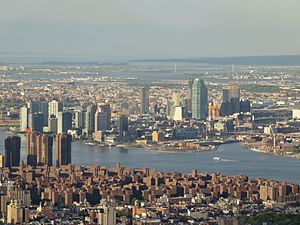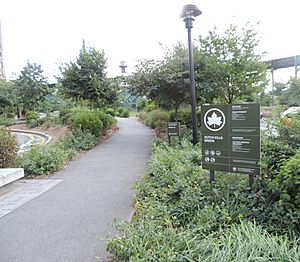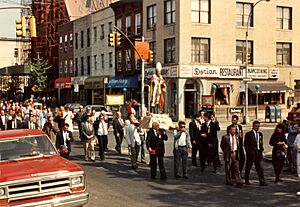Long Island City facts for kids
Quick facts for kids
Long Island City
|
|
|---|---|
|
Neighborhood
|
|

The expanding skyline of Long Island City in Queens, including One Court Square, seen from across the East River opposite Stuyvesant Town–Peter Cooper Village in May 2017
|
|
| Nickname(s):
"LIC"
|
|
| Country | |
| State | |
| City | New York City |
| County/Borough | Queens |
| Community District | Queens 1, Queens 2 |
| Population | |
| • Total | 63,000 |
| Time zone | UTC−5 (EST) |
| • Summer (DST) | UTC−4 (EDT) |
| ZIP Codes |
11101–11106, 11109, 11120
|
| Area codes | 718, 347, 929, and 917 |
Long Island City (LIC) is a lively neighborhood in Queens, one of New York City's five main areas. It sits on the western tip of Long Island. LIC is bordered by Astoria to the north, the East River to the west, Sunnyside to the east, and Newtown Creek to the south. Newtown Creek separates Queens from Greenpoint, Brooklyn.
LIC used to be its own city, starting in 1870. It became part of the larger New York City in 1898. Today, LIC is known for its many new homes, beautiful parks along the water, and a busy art scene. You can find lots of art galleries, art centers, and studio spaces here. The Queensboro Bridge, which connects Queens and Manhattan without tolls, ends in Long Island City. Near the bridge are the Queensbridge Houses, the biggest public housing complex in the Western Hemisphere.
Long Island City is part of two Community Districts: Queens Community Board 1 and Queens Community Board 2. The New York City Police Department's 108th Precinct keeps the area safe.
Contents
How Long Island City Grew Over Time
Becoming a City in 1870
Long Island City officially became a city on May 4, 1870. This happened when several smaller villages and hamlets joined together. These included Astoria, Ravenswood, Hunters Point, and Sunnyside. At that time, about 12,000 to 15,000 people lived in Long Island City. The city had its own mayor and a group of ten aldermen who made laws.
The first mayor, A.D. Ditmars, was elected on July 5, 1870. He ran as both a Democrat and a Republican. In the 1880s, Mayor De Bevoise caused financial problems for the city government due to misusing money. Some residents of Astoria even tried to leave Long Island City and become their own village again, but this didn't happen. Long Island City remained an independent city until 1898. That's when Queens became part of the much larger New York City. The last mayor of Long Island City was Patrick Jerome "Battle-Axe" Gleason.
Joining New York City
In 1898, Long Island City gave up its independence and became part of New York City. However, its identity lives on through its ZIP Codes (like 11101). The Greater Astoria Historical Society has been working since 1985 to preserve the history of the Long Island City area.
During the 1930s, many important connections were built. These included three subway tunnels, the Queens-Midtown Tunnel, and the Queensboro Bridge. These helped connect the neighborhood to Manhattan. By the 1970s, many factories in Long Island City started to close down.
In the 1990s, a large area called Queens West began to be developed. This project aimed to bring thousands of new residents to the East River waterfront. In 2001, the area was changed from mostly industrial to residential. This led to many new buildings and a process called gentrification, where neighborhoods change and become more expensive. Between 2010 and 2017 alone, 41 new apartment buildings were built. By the mid-2010s, Long Island City was one of New York City's fastest-growing neighborhoods.
Important Historic Places
Long Island City has several places listed on the National Register of Historic Places. These include the Long Island City Courthouse Complex and the United States Post Office. Other famous landmarks include the Pepsi-Cola sign along the East River and the New York Architectural Terra-Cotta Company building.
People and Population in LIC
Long Island City is a diverse neighborhood. In 2010, the combined population of Queensbridge, Ravenswood, and Long Island City was about 20,030 people.
The neighborhood has a mix of different ethnic groups. In 2010, about 14.7% of residents were White, 25.9% African American, 15.5% Asian, and 40.5% Hispanic or Latino. More recently, the Asian population has grown a lot, especially since 2010. It now makes up about 34% of the neighborhood's population. These new Asian residents are mainly Chinese, Bengalis, Koreans, and Japanese.
Most adults in Long Island City have a college education or higher. This is a bit more than the average for the rest of New York City. Also, students in Long Island City schools are doing well. The number of elementary school students who are good at math and reading has gone up. High school students in LIC also graduate on time more often than the city average.
Businesses and Buildings in Long Island City
Long Island City used to have many factories and bakeries. Now, some of these old buildings have new uses. For example, the old Silvercup bakery is now Silvercup Studios. This studio has produced famous TV shows like 30 Rock and Sex and the City. You can see the big Silvercup sign from the subway. The former Sunshine Bakery is now part of LaGuardia Community College.
The Standard Motor Products headquarters, an old factory, now houses the Jim Henson Company and a rooftop farm called Brooklyn Grange. A former Pepsi-Cola site on the East River is now home to new high-rise apartments. From 2002 to 2004, the old Swingline Staplers plant was even the temporary home of the Museum of Modern Art.
Long Island City has some of the tallest buildings in Queens. One Court Square, built in 1990, was the tallest building in Queens until 2019. The Orchard residential tower, which is 811 feet tall, is now the tallest building in the borough. Another tall building, Sven, is also located near Queens Plaza.
The Queensbridge Houses is a very large public housing complex in the area. It has over 3,000 homes.
Companies in LIC
Long Island City is home to the largest fortune cookie factory in the United States, owned by Wonton Foods. They make four million fortune cookies every day! The Brooks Brothers tie factory, which makes over 1.5 million ties a year, has been in LIC since 1999. Other companies headquartered here include the independent film studio Troma and Standard Motor Products.
In 2010, JetBlue Airways moved its main office to Long Island City. The airline, which has a big hub at JFK Airport, now has its headquarters in the Brewster Building in Queens Plaza.
In 2018, there was talk that Amazon.com might build one of its new headquarters in Long Island City. This would have brought 25,000 jobs to the area. However, Amazon later decided not to build there due to unexpected opposition.
Neighborhoods Within Long Island City
In 1870, several smaller villages and hamlets joined to form Long Island City. Some of these areas still have their own unique feel.
Dutch Kills Area
Dutch Kills was a small settlement named after a waterway connected to Newtown Creek. It was an important road hub during the American Revolutionary War. The area used to have farms in the 1800s. Later, it became an industrial area. Today, Dutch Kills is changing with new homes and businesses being built.
Blissville Area
Blissville is a neighborhood within Long Island City. It is bordered by Calvary Cemetery to the east and Newtown Creek to the south. It was named after Neziah Bliss, who owned much of the land in the 1830s. Blissville used to be a small village before it joined Long Island City in 1870. It was historically an industrial area.
Hunters Point Area
Hunters Point is located on the south side of Long Island City, along Newtown Creek. It got its name in 1825 from a British sea captain named George Hunter. His family had a large farm there.
The Hunters Point Historic District is a special area with 19 old townhouses built in the late 1800s. This historic district was created in 1968 to protect these buildings. Today, the modern Queens West and Hunter's Point South developments are located along the East River waterfront in Hunters Point.
Arts and Culture in Long Island City
Long Island City is a hub for artists and creative people.
- 5 Pointz was a famous building where graffiti artists could legally paint. It was a very visible landmark near the subway. The building was later painted over and torn down in 2013. The owner had to pay money to the artists as a result. New apartment towers called 5Pointz opened there in 2021.
- Culture Lab LIC is a new group that supports visual art, theater, and music in Western Queens. It operates out of The Plaxall Gallery, a large converted warehouse.
- The Isamu Noguchi Foundation and Museum was founded in 1985 by the Japanese-American sculptor Isamu Noguchi. It's a special place dedicated to his artwork.
- MoMA PS1 is connected to the Museum of Modern Art. It's one of the oldest and largest non-profit art centers in the U.S. that focuses only on contemporary art. It's located in a former public school building.
- SculptureCenter is the only non-profit exhibition space in New York City dedicated to modern and innovative sculpture. It moved to Long Island City in 2002.
- Socrates Sculpture Park is an outdoor park where you can see sculptures. It's located near the Noguchi Museum.
Parks and Fun in LIC
Long Island City has several parks along the waterfront.
- Gantry Plaza State Park is a 12-acre park on the East River. It has great views of Manhattan.
- Hunters Point South Park is another park on the East River waterfront, near Newtown Creek.
- Queensbridge Park is a park located north of the Queensboro Bridge, within the Queensbridge Houses.
Other parks and fun places include:
- Andrews Grove
- Bridge and Tunnel Park
- City Ice Pavilion, an ice skating rink that opened in 2008. It's even on the roof of a storage building!
- Hunters Point Community Park
- Murray Playground
- Old Hickory Playground
Getting Around Long Island City
Public Transportation
Long Island City has many ways to get around using public transport.
- Subway: Several New York City Subway lines serve LIC, including the E, M, G, 7, N, W, and R trains. Key stations include 21st Street–Queensbridge, Court Square–23rd Street, Queens Plaza, and Vernon Boulevard–Jackson Avenue.
- Buses: Many MTA bus routes run through Long Island City, connecting it to other parts of Queens and Manhattan.
- Trains: The Long Island Rail Road (LIRR) has stations at Long Island City and Hunterspoint Avenue. The new East Side Access project, which opened in 2023, now connects LIRR trains directly to Grand Central Terminal in Manhattan.
- Ferries: The NYC Ferry operates routes from Hunters Point South and Gantry Plaza State Park, connecting LIC to Manhattan and other parts of Brooklyn and Queens.
There are also plans for a new light rail system called the Brooklyn–Queens Connector (BQX). It would run along the waterfront from Brooklyn through Long Island City to Astoria.
Roads and Bridges
Cars can enter Long Island City from Brooklyn using the Pulaski Bridge. From Manhattan, you can use the Queensboro Bridge or the Queens–Midtown Tunnel. The Roosevelt Island Bridge connects LIC to Roosevelt Island. Major roads in the area include 21st Street, I-495 (Long Island Expressway), Northern Boulevard, and Queens Boulevard.
Famous People from Long Island City
Many interesting people have connections to Long Island City.
- Several Major League Baseball players were born in LIC, including Joe Benes, Ed Boland, Al Cuccinello, Tony Cuccinello, Gus Sandberg, and Billy Zitzmann.
- Famous hip-hop artists like Marley Marl, MC Shan, Mobb Deep, Nas, and Roxanne Shante grew up in the Queensbridge Houses.
- Other notable residents include:
- Jane Bolin (1908–2007), the first black woman to serve as a judge in the United States.
- Richard Christy (born 1974), a musician and writer for The Howard Stern Show.
- Vern Fleming (born 1962), a former professional basketball player.
- Steve Hofstetter (born 1979), an actor and comedian.
- Levy Rozman (born 1995), a chess International Master and online content creator.
- Metta Sandiford-Artest (born 1979), a former professional basketball player.
- Joe Santagato (born 1992), a comedian and creator of the board game Speak Out.
Images for kids
-
Looking west from an apartment building near Queens Plaza
-
Entrance to Court Square-23rd Street
See also
 In Spanish: Long Island City para niños
In Spanish: Long Island City para niños



















